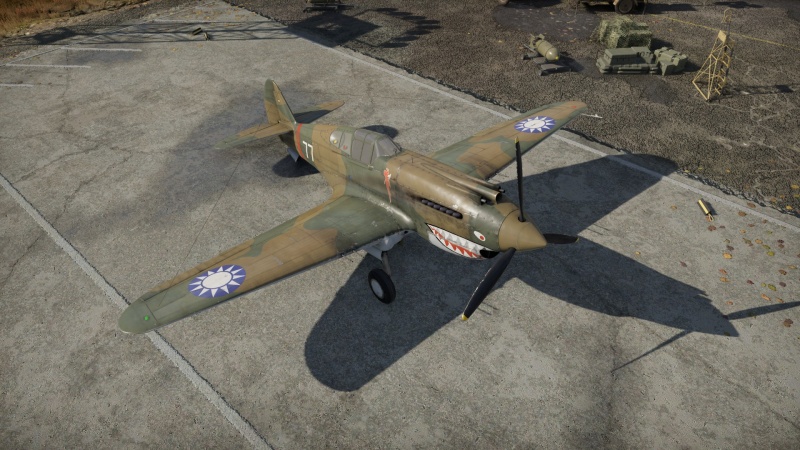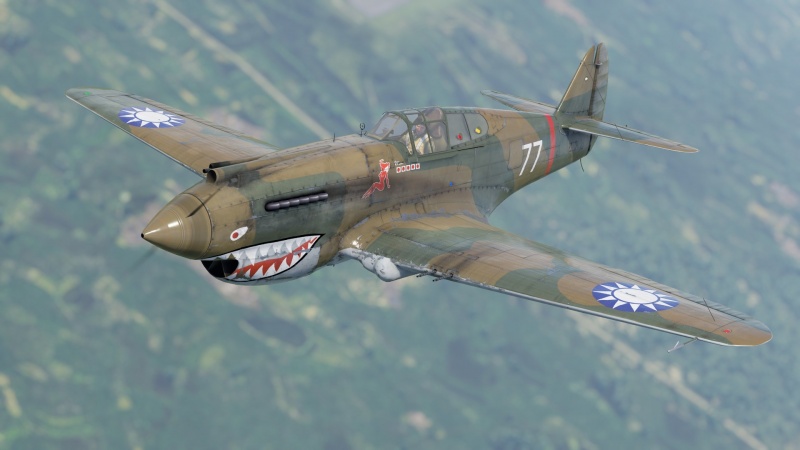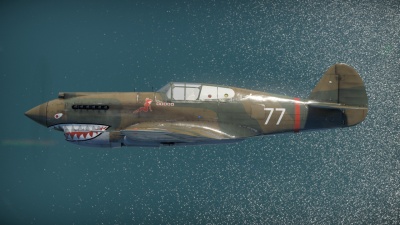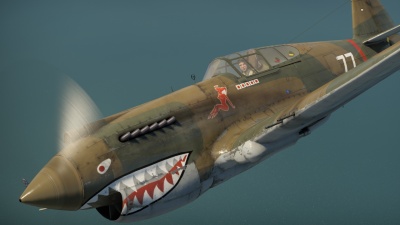H-81A-2
Contents
Description
The H-81A-2 was an export version of the P-40 Warhawk, very similar to the P-40C, these aircraft were exported to China and flown by the Flying Tigers (American Volunteer Group). These models were not very liked by their pilots, they lacked drop tanks for extra range, bomb racks on the wings, their engines were very vulnerable in combat to leaks and overheating, and the base version had no radios, so improvised radio transceivers were installed. The plane also had very poor performance at high altitudes and a slow climb rate. The aircraft was not liked by ground crews either, lack of spare parts and components were common and many damaged aircraft stayed on the ground for years without flying. However, even though it was less agile than the Japanese fighters, its heavy construction and strong airframe meant that the pilot had a decent amount of protection from bullet impacts and the airframe could withstand emergency landings.
It was introduced in Update 1.91 "Night Vision" as a premium pack in the Gaijin store, though it was removed from sale after the 2020 May Sale. The H-81A-2 is an export version of the US P-40 Warhawk and its appearance is very similar to the P-40C. It shares the nose-mounted .50 calibre machine guns of the earlier variants of the P-40, which allows a denser cone of fire in contrast to later revisions of the aircraft. This firepower helps the H-81 stay on par with other similar fighters. However, the H-81 has poor high altitude performance and its climb rate is mediocre at best, but it's still important to climb to high altitudes at the start of the match.
General info
Flight performance
As a P-40, the H-81A-2 suffers from a poor climb rate and mediocre engine performance at high altitudes. To deal with this, side climbing is very recommended at the start of the match, it should be noted that the H-81A-2 has a higher dive speed than most dogfighters like the Spitfire and Hurricane, while it also has a good top speed in level flight, at the same level as aircrafts like the Bf-109.
| Characteristics | Max Speed (km/h at 4,500 m) |
Max altitude (metres) |
Turn time (seconds) |
Rate of climb (metres/second) |
Take-off run (metres) | |||
|---|---|---|---|---|---|---|---|---|
| AB | RB | AB | RB | AB | RB | |||
| Stock | 537 | 521 | 20.0 | 20.7 | 8.8 | 8.8 | 343 | |
| Upgraded | 588 | 561 | 18.0 | 19.0 | 16.4 | 12.0 | ||
Details
| Features | ||||
|---|---|---|---|---|
| Combat flaps | Take-off flaps | Landing flaps | Air brakes | Arrestor gear |
| ✓ | ✓ | ✓ | X | X |
| Limits | ||||||
|---|---|---|---|---|---|---|
| Wings (km/h) | Gear (km/h) | Flaps (km/h) | Max Static G | |||
| Combat | Take-off | Landing | + | - | ||
| 795 | 595 | 530 | 245 | ~13 | ~6 | |
| Optimal velocities (km/h) | |||
|---|---|---|---|
| Ailerons | Rudder | Elevators | Radiator |
| < 420 | < 380 | < 420 | > 310 |
Survivability and armour
- 8 mm steel behind pilot
- 9.5 mm steel behind nose-mounted machine gun ammo
- 38 mm bulletproof glass in front of pilot
- Self-sealing fuel tanks (1 behind pilot, 1 under pilot, 1 under pilot's feet)
Modifications and economy
Armaments
Offensive armament
The H-81A-2 is armed with:
- 2 x 12.7 mm M2 Browning machine guns, nose-mounted (235 rpg = 470 total)
- 4 x 7.62 mm Browning machine guns, wing-mounted (480 rpg outer + 500 rpg inner = 1,960 total)
The offensive armament in the H-81A-2 can be considered underpowered when compared to the more modern variants of the P-40. However it is powerful enough to destroy most fighters with a well placed burst, but it is not powerful enough to consistently destroy enemy bombers.
Suspended armament
The H-81A-2 can be outfitted with the following ordnance:
- Without load
- 1 x 500 lb AN-M64A1 bomb (500 lb total)
With access to a single 500lb bomb, the H-81A-2 is not well suited for ground battles, however it can be used to deal with some light tanks and SPAA.
Usage in battles
The most plausible manner to use this aircraft is in the Boom & Zoom role, given its fast speed in a dive. In addition, the nose-mounted .50 calibre can help you preform certain attacks a P-40E pilot could dream of doing. However, there are certain methods to using the plane, as it is an earlier iteration of the H-81A-2 is a P-40.
The first method is to climb to altitude, and try to intercept enemy attackers and bombers. This tends to play in favour of the H-81A-2, due to its excellent top speed of 528 km/h (328 mph) at 3,800 m (12,467 feet.) That being said though, you are inhibited by its relatively slow rate of climb of only 10 m/s (32 feet/second). On the contrary, once you reach altitude, Boom & Zoom as much as you want against bombers, as your high dive speed will make it difficult for most gunners to target you. In addition, you have a nice turn speed of 21 seconds, which can allow you to snap over on some opponents with relative impunity. If you do find yourself fighting in the vertical, flaps will also be of use to you, as they do have a decent speed tolerance before they snap off.
In Ground RB, you are a nice ground pounder as there is a bombload of 1 x 500 lb bomb plus 2 x .50 cal MGs in the nose. When you spot an enemy ground unit, it is best to climb to around 1,500 m before diving at it. This way you have quite some time to distinguish your target as you dive down, and the speed gathered will also protect you. Recommended diving angle is around 30-70 degrees. Once you speed passes 520 km/h and the target fills up the reticle, pull the reticle right above the top of the target and release the bomb, it will land very close if not directly hit the target. If you cannot dive that fast, aim higher above the target before releasing bomb. After dropping the bomb, the nose-mounted .50 cals are good for strafing tanks' roof armour. Now you want to dive steeper for the bullets to pierce through. When diving, cut throttle and slow down to give yourself a long window to aim and burst, you must fire from a rather far distance since you need some time to pull up from the near-vertical dive. The 12.7 mm AP rounds are good at penetrating roof armour and knocking out crew/modules, giving you kills or assists.
- Simulator Battles
- In Simulator, the H-81 has great potential but is not very friendly to beginners. Its advantages include decent dive and level speed, a surprisingly good turn rate, and adequate visibility over the nose unlike the similar P-40. However what make this plane hard to master is that its weapons of machine guns require landing continuous hits on an aircraft in order to damage/destroy it, yet most players will struggle to align even one pass. It also suffers from severe wobbling, resulting in the gunsight swinging around when trying to adjust the aim, which can make the player miss their chance to fire. Other drawbacks include the limited visibility due to numerous canopy frames and a razorback design, and the engine tends to slowly overheat at 100% throttle. WEP cannot be used for more than half a minute, as it will also heat up the engine quickly.
- Before entering a battle, it is recommended to set keybinds for trimming on all axis and vertical head movements to improve the forward visibility a bit. Like the P-40, the H-81 is nose-heavy so trim the elevator for around +4% depending on your speed. Take at least 30 minutes of fuel. Recommended convergence lies between 250-500 m.
- For dogfighting, because almost all aerial battles in Sim occurs at below 3,000 m, the P-40 can easily climb to this altitude and gather up lots of speed before engaging a battle. The tactic is similar to the RB one above, which is to keep speed and boom and zoom. If, unfortunately, you find yourself being chased on your six and you don't know how to do any defensive manoeuvres, do a large, smooth turn towards the nearest friendly airfield to avoid bleeding too much speed. Then shallow-dive towards your airfield. The P-40 can quite easily outrun opponents like the A6M or I-15, but struggles to outrun Bf 109 F/Gs, Fw 190 A or other P-40s. Another way of disengaging is to do a sudden Split-S to dodge under the chaser. Average Sim players will now try and see where you went, if not immediately losing track of you. You can then run for your airfield or shallow climb for another attack.
- When intercepting player bombers or AI bombers/attackers/reconnaissance aircraft, it is best to get an altitude advantage of at least 800 m before engaging. This way, you can not only BnZ the target which is your common tactic, you also get enough time to smooth the aim as you dive, helping you to score accurate hits. After a pass do not try and stay at their tail and keep shooting, disengage immediately and zoom away, preparing for another pass if needed. Chasing behind a bomber makes yourself pretty much stationary for the tail gunners, and you will be showered with bullets. The huge engine & cooling systems of the H-81 will usually get damaged which is fatal if you are far from friendly airfield.
Specific enemies worth noting
Perhaps the biggest threat comes from facing any Japanese plane at this battle rating. They can turn so much faster than you as to bleed your speed and energy to the point of stalling out. The greatest threats come from the Ki-44s and the A6M2-N. In addition, the Ki-43 has significantly greater manoeuvrability than you. The vast majority of these planes have guns similar in calibre to a .50 Cal, which means that they have the firepower to dispatch you at a fairly fast rate. The H6K & H8K are very spacious flying boats, being most threatening in Simulator since it is much harder for the interceptor to aim precisely like in realistic battles. They have fairly deadly 20 mm defensive cannons facing backwards, so avoid tailing them from their six unless the gunner is unconscious. Engage from their sides or high six and aim for the wings. Your 2 x 12.7 mm + 4 x 7.62 mm MGs will cripple its wing structures easily or set it aflame if you are lucky. Don not engage if you have no altitude advantage.
In terms of the British, any Spitfire or Hurricane will out-turn you. While they do not have as heavy of armament as you do, the shear rate of fire from the .308s can light up exposed ares of the plane, or even score a pilot kill. While it is mostly unlikely, the Spitfire Mk. IIb not only boasts manoeuvrability, but also two 20 mm Hispano cannons, which can tear you to bits. In addition, almost all British fighters can out-climb you, which leaves you at a disadvantage in energy.
The Germans have the most planes that can give you a problem, due to the vast majority of them having 20 mm cannons. Most notably are aircraft like the Bf-110 and the Bf 109 E-3. You also do have to worry about aircraft like the Bf 109 F-1, which has a 20 mm cannon in the propeller hub. While it is unlikely, you may also face the Fw 190 A-1. Most German planes will have a significantly better climb rate than you and be able to energy fight you more efficiently. As mentioned earlier, most German planes boast much heavier firepower than you, which renders you at a disadvantage in punching power.
Most Soviet planes will also give you a run for your money. Almost all of the Soviet planes boast only nose-mounted weaponry, giving them a significant advantage over most allied planes. The most common enemies to worry about are any plane with the prefix "Yak". Perhaps the most common cause of US teams being defeated by the Soviets, is the fact that they head on an IL-2. Never under any circumstance head on an IL-2.
In Ground RB, avoid SPAAs at all cost. If you are the only aircraft up and there are SPAAs firing towards you, get away from them. Although the H-81 is armoured by steel armour plates and bulletproof glass, it is still very vulnerable to calibre 12.7 mm and above shells. Direct hits will usually damage your huge cooling system which can result in a crash. However, if a teammate plane gets the attention of enemy SPAA, you can sneak up on them. At this BR, common SPAAs include M16, Flakpanzer 38 and Sd.Kfz. 6/2.
Counter-tactics
As mentioned earlier, the H-81A-2 has nose-mounted .50 cals, which can make short work of almost any fighter at battle rating 2.3. The aircraft also has a tighter turning time than the P-40E, which can give a H-81A-2 pilot a small advantage. If a H-81A-2 finds its way onto your tail, try to make the pilot over-shoot or bleed energy. The cockpit, while having more protection than an open top and a bubble canopy, is still a fairly vulnerable spot, so pilot snipes aren't uncommon.
Heads up for German and Soviet pilots! While aircraft like the Bf-110, LaGG-3 and the Yaks have nose-mounted weaponry, an experienced H-81A-2 player can still make you pay dearly in a head-on. If you find yourself in a head on with a H-81A-2, fire a short burst, then hit the deck to avoid being hit by return fire. This is especially true with the Soviets due to their wooden airframe.
Manual Engine Control
| MEC elements | ||||||
|---|---|---|---|---|---|---|
| Mixer | Pitch | Radiator | Supercharger | Turbocharger | ||
| Oil | Water | Type | ||||
| Controllable | Controllable Auto control available |
Not controllable Not auto controlled |
Controllable Auto control available |
Combined | Not controllable 1 gear |
Not controllable |
Pros and cons
Pros:
- Good firepower with plenty of ammo
- Good manoeuvrability
- Good rate of climb for the rank
- High top speed for its rank
- Fast dive speed and dive acceleration
- Good durability
- Significantly better over-the-nose visibility than the identical P-40, giving it a huge advantage in Simulator dogfights
- One 500 lb bomb allows it to attack tanks in ground RB
- .50 cals are nose-mounted, concentrating their firepower
Cons:
- Heavy weight and weak engine results in very poor energy retention, will lose all the speed & altitude after around 2 BnZ passes
- Engine overheats fast while using WEP, limiting its power output
- Rudder locks up past 520 km/h
- Somewhat long takeoff run
- .30 cals may struggle to do effective damage once the ammo for the .50 cals runs out
- Only one payload option of a single 500 lb bomb
- Numerous canopy frames and razorback cockpit severely limit the pilot's all-round and backwards view in Simulator
History
The H-81A-2 is one of the export versions given to the ROC through the American Volunteer Groups sent to China. The volunteer force was sent by US president Franklin Roosevelt to deter Japanese aggression during the Second Sino-Japanese War. At the time these aircraft were a relief for the Chinese aid as the aircraft they were using at the time, primarily I-16s and I-15s, did not compete well against the Japanese air force. The only unit of these volunteer groups to actually see combat against the Japanese forces was the 1st AVG, otherwise known as the "Flying Tigers". Some records suggest that when building the aircrafts made for China, Curtiss employed leftover materials and components, making the aircraft more similar to the P-40B instead of the C variant, which was the one to be exported. For example, some of this aircrafts lacked internal membranes for self sealing fuel tanks, and instead relied in external self sealing coating. They also lacked regular features of the P-40C, like the external drop tanks, the additional armour for the pilot and radio equipment. It also did not help that the ROC decided to buy this aircraft without many essential components, like wing guns and reflector gunsights.
The H-81 makes reference to the Curtiss Model 81 Tomahawk of the P-40 family, the H-81A-2 given to the Republic of China was a hybrid between the regular Tomahawk IIA/B also known as P-40B/C. The Flying Tigers was the main operator of this aircraft with a peak of 3 squadrons in service and 60 aircrafts in average. The aircrafts originally stayed in Burma, with 100 being exported to the ROC by Curtiss, however Curtiss was only able to procure 99 finished aircrafts before the Attack on Pearl Harbour, the 100th fuselage was sent to China and later finished with surviving parts from damaged aircrafts. The aircraft was not as nimble as the Japanese Oscars, but their pilots did appreciate the robustness of the airframe, that allowed for relatively safe emergency landings, and overall more survivability. To overcome the issues of the aircraft, pilots employed innovative tactics for early warning, like a large network of spotters, that allowed the P-40s to climb to a desired altitude without hurry and then use Boom and Zoom tactics, using the higher diving speed of the P-40 when compared to Japanese fighters. At the end of their deployment however, some of the original P-40Cs started to be replaced by P-40Es, when the USAAF procured 50 replacement P-40Es to be used in China.
Media
- Skins
- Images
- Videos
See also
- Related development
- Aircraft of comparable role, configuration and era
External links
| Curtiss-Wright Corporation | |
|---|---|
| Fighters | BF2C-1 |
| P-36A · Rasmussen's P-36A · P-36C · P-36G | |
| P-40C · P-40E-1 · P-40F-10 | |
| Bombers | SB2C-1C · SB2C-4 |
| Floatplanes | SOC-1 |
| Experimental | XP-55 |
| Export | H-75A-1 · H-75A-4 · H-81A-2 · ▂P-40E-1 · ␗P-40E-1 · ▄P-40F-5 Lafayette · CW-21 · Hawk III |
| ▄SB2C-5 | |
| Captured | ▀Hawk H-75A-2 |
| China fighters | |
|---|---|
| British | ␗Gladiator Mk I |
| French | D.510C |
| Japanese | ␗A6M2 · ␗Ki-27 otsu · ␗Ki-43-III ko · ␗Ki-44-II hei · ␗Ki-61-I otsu · ␗Ki-84 ko |
| American | CW-21 · Hawk III · P-66 · ␗P-40E-1 · H-81A-2 · ␗P-43A-1 |
| ␗P-47D-23-RA · ␗P-47D-30 · ␗F-47N-25-RE · ␗P-51C-11-NT · ␗P-51D-20 · ␗P-51K | |
| Soviet | ␗I-15bis · ␗I-153 M-62 · ␗I-16 Chung 28 · ␗I-16 type 5 · ␗I-16 type 10 · ␗I-16 type 17 · ␗La-11 · ␗La-9 |
| China premium aircraft | |
|---|---|
| Fighters | ␗A6M2 · D.510C · ␗F-47N-25-RE · H-81A-2 · Hawk III · ␗Ki-45 hei/tei · ␗Ki-84 ko · ␗P-51C-11-NT |
| Jet fighters | Shenyang F-5 · J-7D |
| Strike aircraft | A-5C · ␗F-84G-31-RE |








